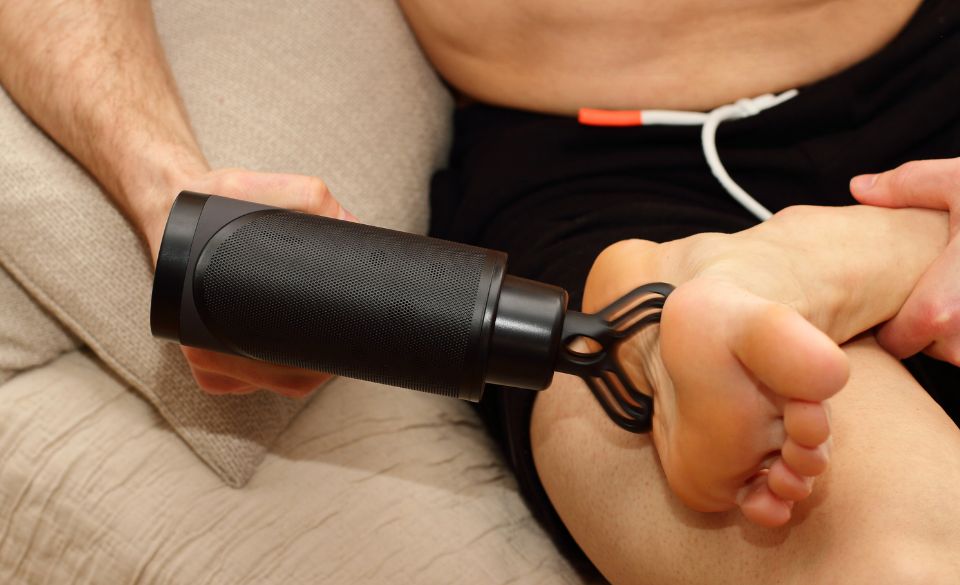
Can A Massage Gun Help Your Running?
Page Contents
In recent years, massage guns have taken the world of recovery tools by storm. These handheld devices, resembling nail guns in their design, offer percussive massage as a means to aid recovery and alleviate muscle tension. Yet, amid the buzz surrounding these devices, one question looms large: Are massage guns a worthy investment for runners? And if so, how can they be effectively utilized to optimize running performance?
While the technology underpinning these massage guns is not entirely new, with percussive massage research dating back to the 1960s, their role in the running world remains a subject of curiosity. To unravel the potential benefits and address the query of whether a massage gun can truly enhance your running journey, let’s delve into the mechanics, applications, and the impact of these devices.
How A Massage Gun Works
In comparison to a foam roller, a massage gun offers a different approach to muscle care. While foam rolling primarily focuses on providing myofascial release and targeting adhesions within the muscle fascia, a massage gun takes a unique approach. By delivering localized vibrations directly to the muscle, it stimulates a response from the central nervous system. This response can result in muscle activation and heightened proprioception, which is your awareness of how the muscle is moving. These characteristics make a massage gun a versatile tool that can benefit both pre-run warm-up and post-run recovery routines for runners.
How To Use A Massage Gun
Many massage guns, such as the Opove Apex, arrive with clear instructions for proper usage, particularly when they include multiple attachments and settings. It’s crucial to read these instructions attentively to ensure that you’re making the most of your massage gun.
In general, it’s advisable to commence your massage gun session at a lower setting to gauge how your body responds. The duration of use on a specific muscle should be determined by several factors, including the selected setting, the muscle in focus, and your intended goal (as discussed below). Remember that when it comes to massage guns, longer is not necessarily better. Overzealous use of these devices, just like with foam rolling, could potentially lead to increased muscle soreness rather than the desired relief.
Exploring the Advantages of a Massage Gun
Massage guns offers two primary benefits to its users. It can effectively reduce post-workout or post-lift soreness when applied after exercise, and it can enhance overall performance when integrated into your pre-workout routine.
That’s right – unlike conventional recovery tools, some of which are typically used after a workout, a massage gun shines when utilized before your run as part of a dynamic warm-up.
Although recovery tools are conventionally associated with post-workout relief, it’s well worth trying out a massage gun before your run to gauge its potential impact. Incorporating a massage gun into your pre-run routine may lead to an improved range of motion and, in some cases, enhanced running performance. However, it’s crucial to keep in mind that longer massage sessions don’t necessarily equate to better performance. For optimal results, limit your massage gun usage to no more than 1-2 minutes per muscle group, especially if your aim is to boost performance.
What The Studies Say
Research has indicated that percussive massage may contribute to increased range of motion. For instance, a 2020 study published in the Journal of Sport Science and Medicine discovered that a 5-minute percussive massage applied to the calves led to a significant increase in the range of motion for the foot and ankle. This can be particularly advantageous for athletes prone to injuries, as improved range of motion before a run can have a positive impact.
When incorporating a massage gun into your recovery regimen, it’s essential to understand that it does not replace the practice of foam rolling. Instead, these two methods complement each other and can be used together to effectively reduce muscle soreness. A 2017 study featured in the European Journal of Applied Physiology reported that 15 minutes of percussive massage not only provided immediate relief from muscle soreness but also delivered short-term relief. It’s important to note that muscle strength may not necessarily improve through the use of a massage gun, so while you might feel better, adequate time for recovery is still essential before embarking on your next demanding workout.
Is Investing in a Massage Gun Justifiable?
In all honesty, running isn’t known for its affordability, and the price tag of massage guns can be quite steep. Moreover, not every runner necessarily requires one! It’s imperative to ensure that you’ve covered the essential aspects of training wisely. If you suspect any deficiencies in this area, perhaps your initial step should involve hiring a coach. Furthermore, prioritizing strength training may be the key, and if that’s a stumbling block, you might want to contemplate investing in a home gym. Don’t forget the significance of maintaining a healthy sleep schedule, adopting a balanced diet, and giving yourself proper rest days.
Only once you’ve established a solid foundation and wish to incorporate an extra dimension into your routine should you consider the addition of a massage gun to your arsenal.
Is a Massage Gun a Vital Requirement?
To put it simply, no. A massage gun should not be regarded as a substitute for fundamental recovery practices like prioritizing adequate sleep, maintaining a well-balanced nutrition plan, and following a structured training regimen that incorporates essential rest days. It is by no means a necessity for achieving your running objectives. Nevertheless, if you’ve diligently tended to the primary aspects of recovery and are seeking an additional dimension to enhance your regimen, a massage gun could serve as an enjoyable supplementary tool in your repertoire of running recovery strategies.
If You Plan On Purchasing A Massage Gun For Recovery
Avoid using a massage gun if:
– You are taking blood thinners.
– If you experience easy bruising.
– If you have diminished nerve sensation (diabetes, neuropathy, etc.).
– You currently have an active injury (sprain, strain, fracture, etc.).
– It causes discomfort or pain when used.
It should be emphasized that the massage gun should never be used over a crucial artery, like those in the neck or abdomen.
Additionally, it’s crucial to understand that a massage gun is not intended for treating injuries. In fact, applying a massage gun to an acute injury, such as a sprain or stress fracture, could potentially exacerbate the condition.
Final Words – Can A Massage Gun Help Your Running?
Research has suggested that percussive massage may contribute to increased range of motion, making it beneficial for injury-prone athletes. When added to your recovery regimen, a massage gun should complement rather than replace foam rolling, as both methods are effective in reducing muscle soreness.
The decision to invest in a massage gun should be made wisely, considering your overall training and recovery strategy. It’s essential to ensure you’ve covered the fundamental aspects of your regimen, including proper training, strength work, nutrition, and recovery. A massage gun is not a necessity but can serve as a valuable supplementary tool if you’ve addressed these primary requirements.
If you decide to purchase a massage gun, remember that it should not be used if you are on blood thinners, bruise easily, have a loss of nerve sensation, are recovering from an active injury, or experience discomfort during use. Additionally, always avoid applying the massage gun over vital arteries in the neck or abdomen, and never use it as a treatment tool for acute injuries, as it may exacerbate the condition.
In conclusion, while massage guns can be a useful addition to your running recovery toolkit, they should be approached with caution and only considered once you’ve established a solid foundation of training and recovery practices.



